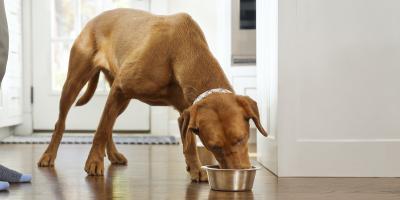As a pet owner, you want your dog to interact well with other people and with other canines. Socializing a dog is an important step in their development and in helping them become a good citizen.
Whether you have a brand new puppy or adult dog, here’s what you need to know about socialization.
Benefits of Socialization
A well-adjusted dog is a happy dog. Learning how to interact with dogs, people and the world at large can prepare your pet for different experiences throughout their life. It can also curb reactive or aggressive behavior and teach them how to manage big feelings such as stress and excitement.
Positive Associations
A major goal of socialization is to help dogs form positive associations.
In many shelters, a big part of getting dogs and puppies ready for the adoption floor is having volunteers and staffers play with them. That's because play – even something as simple as fetch – allows dogs to have fun and safe interactions with people. Then, when they meet others outside the shelter, they’re more likely to feel calm and comfortable.
When Should I Start Socializing My Dog?
Typically, puppies become curious about new experiences at approximately three weeks of age. Around 12 to 16 weeks is when they begin to understand what defines normal dog behavior. They are also more receptive to boundaries set by you.
How to Socialize a Dog With Other Dogs
When it comes to dog socialization, proceed with caution. Puppies usually love to be around other puppies, but some adult dogs who haven't been socialized adequately at an earlier age may find the pressure to play with other dogs stressful.
If you bring your dog to a place full of other dogs, at first it may be best to keep them close to you and reward them for sitting quietly while other dogs pass by. Teaching your dog “come,” “sit” and “look at me” are important commands that can allow you to defuse potentially difficult situations with other dogs.
Also, avoid dog parks at an early age. They can be stressful and your puppy may have a bad experience that can stay with them their entire life. Puppy classes with dogs of similar ages to yours are a great alternative to a dog park.
Tips for Socializing
- Introduce your puppy to your friend’s healthy, well-mannered dogs (as well as other pets and animals)
- Have your dog engage with a variety of people, spanning age, ethnicity, gender and abilities
- Show them different textures and objects
- Keep introductions brief
- Offer your dog treats during greetings
Supervise Play
It’s tempting to let your dog have their own experiences without interference from you. However, socializing puppies should always be supervised. Normal play behavior may include reciprocal chasing and wrestling.
If your dog seems anxious or stiff, try redirecting them by giving them a ball or leading them on a walk. This gives them something else to focus on while remaining in each other’s presence.
Join a Puppy Socialization Class
Dog socialization training classes offer a way for young dogs to figure out how to have positive, safe interactions. Puppies can join them around eight weeks of age, and it’s recommended they receive one round of vaccines seven days prior to starting the class.
Good classes will not be free-for-all puppy chaos. Rather, they should feature instructors who monitor playing between dogs.
Socializing an Adult Dog
If you adopted an adult dog who was not socialized as a puppy, they may get anxious around other dogs or people. Expose them to their source of stress gradually and from a distance. It’s important to reassure your dog (treats can work, too) during this time so they can begin to form positive associations with the experience.
Once your dog seems calm, walk them closer to their trigger, but watch for signs of fear, such as yawning, lip-licking, panting when not hot, or even dragging and over-excitement.
Avoid Stressful Interactions
Remember, playing with other dogs should be fun for your dog. If they exhibit stress, it may be best to stop the interaction and enjoy some other activities.
Tail tucking, escaping and barking are all signs that your dog isn’t having a good time. Remove them from the interaction. Forcing them to confront stress that’s clearly overwhelming may backfire and create fear.
For more helpful training insights, check out the myPurina app.
Learn more socialization tips from our experts. You can also visit our Pet Expertise page.
For your own personalized dog training plan, download Zigzag, the most advanced dog training app, for free and unlock 1 month of Premium Access with unlimited lessons, tailored guidance, and 24/7 expert support using code PUR30 at payment.
Install Zigzag for free now to get started
Related articles

Reward Yourself with myPurina
Earn and redeem rewards for Purina products with the myPurina app.








